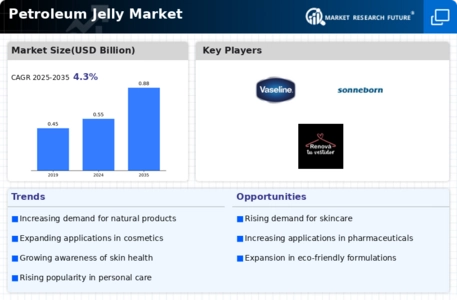Market Trends
Key Emerging Trends in the Petroleum Jelly Market
The petroleum jelly market is witnessing notable trends influenced by various factors that impact both supply and demand dynamics. One significant trend is the increasing awareness and adoption of petroleum jelly in personal care and pharmaceutical applications. With its versatile properties, petroleum jelly serves as a cost-effective and multipurpose ingredient in skincare products such as moisturizers, lip balms, and ointments. This trend is driven by growing consumer concerns regarding skin health and hydration, prompting the use of petroleum jelly as a trusted and effective solution for dryness, chapping, and minor skin irritations.
Another prominent trend in the petroleum jelly market is the expansion of product offerings and formulations to cater to diverse consumer preferences and needs. Manufacturers are innovating to develop enhanced formulations with added vitamins, botanical extracts, and fragrance options to appeal to different target demographics and market segments. Additionally, there is a growing demand for specialty petroleum jelly products tailored to specific applications such as baby care, wound healing, and cosmetic formulations, driving product differentiation and innovation in the market.
Furthermore, the market is experiencing increasing adoption of petroleum jelly in industrial and commercial applications beyond personal care. Petroleum jelly's lubricating and moisture-sealing properties make it a valuable ingredient in various industrial processes, including machinery maintenance, metalworking, and electrical insulation. This trend is fueled by the versatility and cost-effectiveness of petroleum jelly compared to alternative lubricants and sealants, driving demand growth in industrial and commercial sectors.
The petroleum jelly market is also influenced by regulatory factors and sustainability initiatives impacting production and supply chains. As concerns over environmental sustainability and petrochemical usage continue to rise, there is a growing demand for eco-friendly alternatives and sustainable sourcing practices within the petroleum jelly industry. Manufacturers are exploring bio-based and renewable sources of petroleum jelly, as well as implementing measures to reduce carbon emissions and minimize environmental impact throughout the production process.
Moreover, the market is witnessing increased competition and consolidation among key players, leading to strategic partnerships, mergers, and acquisitions to strengthen market positions and expand product portfolios. As the industry becomes more consolidated, companies are focusing on innovation, efficiency, and market expansion to maintain competitiveness and drive growth. This trend is driving investments in research and development, as well as market expansion strategies to tap into emerging markets and untapped opportunities in the petroleum jelly market.
On the supply side, the petroleum jelly market is influenced by factors such as crude oil prices, refining capacity, and geopolitical dynamics. Fluctuations in crude oil prices and supply chain disruptions can impact the production and pricing of petroleum jelly, leading to volatility in the market. Additionally, geopolitical tensions and trade policies can affect the availability and pricing of raw materials and finished products, influencing market dynamics and supply chain resilience.


 Source: Secondary Research, Primary Research, Market Research Future Database and Analyst Review
Source: Secondary Research, Primary Research, Market Research Future Database and Analyst Review



Leave a Comment